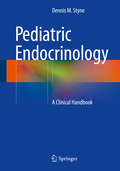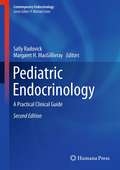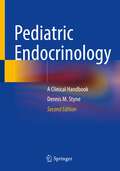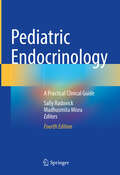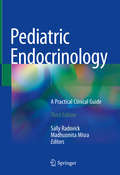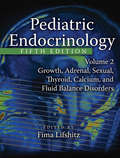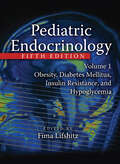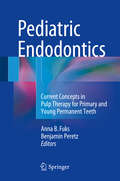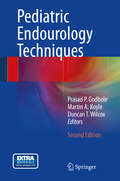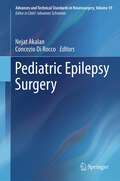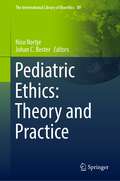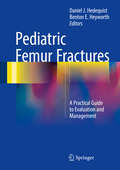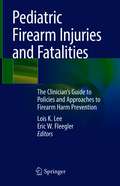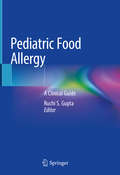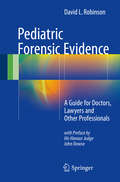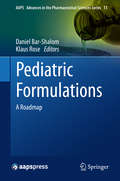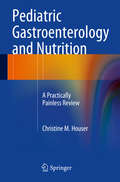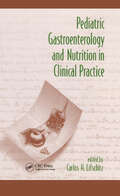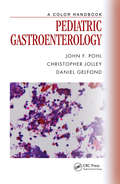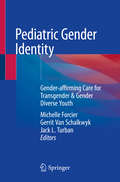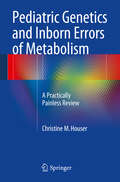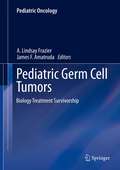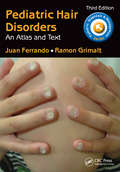- Table View
- List View
Pediatric Emergency and Critical Care Ultrasound
by Stephanie J. Doniger MD RDMS FAAP FACEPEmergency bedside ultrasound assessment is well established for adult patients, but has only recently been introduced into everyday clinical practice for the care of pediatric patients. Pediatric Emergency Critical Care and Ultrasound is a concise, practical text which explains the principles of ultrasound, its diagnostic application in all organ systems and its use as a procedural adjunct. Both well-established and innovative applications are described, assisting the practitioner in incorporating ultrasound into daily practice, facilitating patient care and decreasing radiation exposure. Case studies and abundant illustrations enable the reader to study the appropriate techniques in detail and learn from real examples from the pediatric emergency department and intensive care unit. Pediatric Emergency Critical Care and Ultrasound is the first comprehensive bedside ultrasonography resource focusing on pediatric patients and is essential reading not only for pediatric emergency medicine subspecialists but for all emergency physicians, intensivists/critical care physicians and pediatricians.
Pediatric Endocrinology
by Dennis M. StyneThis text provides a concise, straightforward and clearly written approach for the evaluation of common topics in pediatric endocrinology. Pediatricians, family physicians, residents, fellows and medical students will benefit from the discussion of endocrine physiology and its application to common clinical practice. The text presents the major signs and symptoms and the diagnosis and management of pediatric endocrine disorders. The information presented can prepare a provider for communication with parents of a child with an endocrine condition and may allow the practitioner to avoid an unnecessary consultation. The concepts covered in the text are designed to address the first 10 headings in the content outline of the Sub-board of Pediatric Endocrinology of The American Board of Pediatrics with varying degrees of specificity. The Suggested Reading sections at the conclusion of each chapter direct the reader to outstanding larger and more detailed texts, manuscripts and websites which offer increased detail.
Pediatric Endocrinology
by Sally Radovick Margaret H. MacgillivrayA state-of-the-art and concise guide to the clinical management of pediatric endocrine disorders, the second edition of the highly regarded Pediatric Endocrinology: A Practical Clinical Guide covers the most common and challenging conditions seen by practicing endocrinologists and primary care physicians, including growth, hypothalamic, pituitary, adrenal, thyroid, calcium and bone, and reproductive disorders, as well as metabolic syndromes. This expanded second edition includes new topics being seen more commonly in pediatric endocrinology practices related to obesity and type 2 diabetes mellitus and lipid disorders. Each chapter contains an introductory discussion of the problem, a review of the clinical features that characterize it, the criteria needed to establish a diagnosis, and a comprehensive therapy section delineating the risks and benefits of the best therapeutic options available. Invaluable tables summarize the critical factors in etiology, clinical presentation, diagnosis, and therapeutic dosages. Pediatric Endocrinology: A Practical Clinical Guide, Second Edition, is a comprehensive resource for all clinicians concerned with the myriad endocrinologic disorders seen in children and adolescents.
Pediatric Endocrinology: A Clinical Handbook
by Dennis M. StyneNow in a revised and expanded second edition, this concise, straightforward and clearly written text presents the latest information on the evaluation and management of common issues and conditions in pediatric endocrinology. Endocrinologists, pediatricians, family physicians, residents, fellows and medical students will all benefit from the discussion of endocrine physiology and its application to common clinical practice. As in the original edition, the text presents the major signs and symptoms in the diagnosis and management of pediatric endocrine disorders, often allowing the practitioner to avoid an unnecessary consultation and preparing a provider for informed communication with parents of a child with an endocrine condition. The concepts covered in the text are designed to address the first 10 headings in the content outline of the Sub-board of Pediatric Endocrinology of The American Board of Pediatrics: disorders of the hypothalamic-pituitary axis, growth, calcium metabolism and bone, the thyroid gland, puberty, and the adrenal gland, among others. Concluding each chapter is a Suggested Reading section, directing the reader to outstanding larger and more detailed texts, manuscripts and websites that offer increased detail.Practical and user-friendly, Pediatric Endocrinology, Second Edition is not simply a checklist of everything that could be done but leads the reader toward a more specific goal of what should be done.
Pediatric Endocrinology: A Practical Clinical Guide
by Sally Radovick Madhusmita MisraNow in its revised and updated fourth edition, this state-of-the-art clinical textbook presents the current diagnosis and management of pediatric endocrine diseases and disorders as seen by practicing endocrinologists and primary care physicians. Seven thematic sections present the latest evidence for the management of growth, hypothalamic, pituitary, adrenal, thyroid, calcium and bone, and reproductive disorders, as well as metabolic syndromes and endocrine emergencies. This fourth edition includes new topics such as conditions of overgrowth, low bone density and its management, endocrine issues related to sexual identity, mineralocorticoid disorders and endocrine hypertension, and endocrine emergencies. All chapters have been expanded to discuss recent advances in the field, and each chapter contains key points, an introductory discussion of the problem, a review of the clinical features that characterize it, the criteria needed to establish a diagnosis, and a comprehensive therapy section delineating the risks and benefits of the best therapeutic options available. Completing each chapter are concluding sections presenting relevant case material and multiple-choice review questions for students, residents and fellows. Pediatric Endocrinology: A Practical Clinical Guide, Fourth Edition is a comprehensive resource for all clinicians concerned with the myriad endocrine disorders seen in children and adolescents.
Pediatric Endocrinology: A Practical Clinical Guide (Contemporary Endocrinology)
by Sally Radovick Madhusmita MisraA state-of-the-art and concise resource presenting the clinical management of pediatric endocrine diseases and disorders, this third edition of the highly regarded textbook covers the most common and challenging conditions seen by practicing endocrinologists and primary care physicians, including growth, hypothalamic, pituitary, adrenal, thyroid, calcium and bone, and reproductive disorders, as well as metabolic syndromes. This expanded third edition includes new topics such as conditions of overgrowth, low bone density and its management, endocrine issues related to sexual identity, mineralocorticoid disorders and endocrine hypertension, and endocrine emergencies. Some existing chapters are expanded to take into account recent advances in the field. Each chapter contains key points, an introductory discussion of the problem, a review of the clinical features that characterize it, the criteria needed to establish a diagnosis, and a comprehensive therapy section delineating the risks and benefits of the best therapeutic options available. New to this edition are concluding sections in each chapter containing relevant case material and multiple choice review questions. Pediatric Endocrinology: A Practical Clinical Guide, Third Edition is a comprehensive resource for all clinicians concerned with the myriad endocrinologic disorders seen in children and adolescents.
Pediatric Endocrinology: Growth, Adrenal, Sexual, Thyroid, Calcium, and Fluid Balance Disorders
by Fima LifshitzCelebrating more than twenty years as the single best source in the field, this Fifth Edition has now expanded into two cornerstone volumes with 53 fully inclusive chapters and 73 renowned contributors that comprehensively address every topic and trend relevant to the identification, diagnosis, and management of endocrine and endocrine-related diso
Pediatric Endocrinology: Obesity, Diabetes Mellitus, Insulin Resistance, and Hypoglycemia
by Fima LifshitzCelebrating more than twenty years as the single best source in the field, this Fifth Edition has now expanded into two cornerstone volumes with 53 fully inclusive chapters and 73 renowned contributors that comprehensively address every topic and trend relevant to the identification, diagnosis, and management of endocrine and endocrine-related diso
Pediatric Endodontics
by Anna B. Fuks Benjamin PeretzThis book provides dental professionals with a clear understanding of current clinical and scientific knowledge on the various aspects of pulp treatment for both primary and young permanent teeth. Diagnostic parameters are clearly presented, along with step-by-step descriptions of clinical procedures, including indirect and direct pulp treatments, pulpotomy, and pulpectomy. The rationale for the materials used in each technique and their individual merits and disadvantages are examined in detail. In the case of pulpotomy, all the materials used since the introduction of this treatment modality are discussed (e. g. , formocresol, glutaraldehyde, ferric sulfate, and MTA) and the roles of sodium hypochlorite, electrofulguration, and laser therapy are elucidated. Special attention is devoted to pulpectomy and root canal treatment, with consideration of debriding and obturation techniques, rinsing solutions, and root-filling pastes. A further individual chapter is dedicated to restorations of teeth treated with the different types of pulp therapy. The various conservative treatment modalities are also presented, including specific treatments for immature nonvital permanent teeth. The concluding chapter looks to the future and the potential value of stem cells in pulp therapy.
Pediatric Endourology Techniques
by Duncan T. Wilcox Prasad P. Godbole Martin A. KoylePediatric Urology has rapidly developed as a separate subspecialty in the last decade. During this time, significant advances in technology and instrumentation has meant that increasingly more procedures can be performed by the minimally invasive route. However, access to and availability of adequate training facilities and resources continues to hinder surgeons in achieving experience and expertise in the minimally invasive techniques in paediatric urology. Pediatric Endourology Techniques 2nd edition is a fully illustrated text with an accompanying web application which addresses these issues. The aim of this 2nd edition is to enable surgeons to carry out commonly performed minimally invasive pediatric urological procedures. This book has been organised systematically to enable quick reference to the topic of interest. It encompasses not only the majority of commonly performed pediatric endourological procedures in a standardised format but also newer techniques and procedures that have developed since publication of the first edition. A list of specific relevant reading material is given at the end of each chapter. Pediatric Endourology Techniques 2nd Edition is a valuable tool for pediatric urologists as well as pediatric surgeons, general surgeons, adult urologists and those with an interest in minimally invasive surgery.
Pediatric Epilepsy Surgery
by Concezio Di Rocco Nejat AkalanThe contributions in this volume cover recent advances and changing concepts on diagnosis and treatment of resistant epilepsy in children. Topics treated are new insights on mechanisms of epileptogenesis in developing brain, multimodality imaging in pediatric intractable epilepsy, pediatric intractable epilepsy syndromes, pediatric temporal lobe epilepsy surgery, critical review of palliative surgical techniques for intractable epilepsy, treatment modalities for intractable epilepsy in hypothalamic hemartomas, contemporary management of epilepsy in tuberous sclerosis.
Pediatric Ethics: Theory and Practice (The International Library of Bioethics #89)
by Nico Nortjé Johan C. BesterThis book assists health care providers to understand the specific interplay of the roles and relationships currently forming the debates in pediatric clinical ethics. It builds on the fact that, unlike adult medical ethics, pediatric ethics begins within an acutely and powerfully experienced dynamic of patient-family-state-physician relationship. The book provides a unique perspective as it interacts with established approaches as well as recent developments in pediatric ethics theory, and then explores these developments further through cases. The book first focuses on setting the stage by introducing a theoretical framework and elaborating how pediatric ethics differ from non-pediatric ethics. It approaches different theoretical frameworks in a critical manner drawing on their strengths and weaknesses. It helps the reader in developing an ability to engage in ethical reasoning and moral deliberation in order to focus on the wellbeing of the child as the main participant in the ethical deliberation, as well as to be able to identify the child’s moral claims. The second section of the book focuses on the practical application of these theoretical frameworks and discusses specific areas pertaining to decision-making. These are: the critically ill child, new and enduring ethical controversies, and social justice at large, the latter of which includes looking at the child’s place in society, access to healthcare, social determinants of health, and vaccinations. With the dynamic changes and challenges pediatric care faces across the globe, as well as the changing face of new technologies, no professional working in the field of pediatrics can afford not to take due note of this resource.
Pediatric Femur Fractures
by Daniel J. Hedequist Benton E. HeyworthBringing together the many considerations and complexities surrounding the management pediatric femur fractures, this up-to-date, comprehensive book discusses all aspects of these common but challenging injuries, where the treatment strategies are rapidly changing and which have the potential for complications and less than ideal outcomes. Because there may be multiple acceptable treatment approaches to a given fracture, we sought to review the full spectrum of therapeutic modalities. The entirety of the pediatric femur is considered, including femoral head and neck fractures, diaphyseal, physeal and epiphyseal fractures, and intra-articular fractures of the distal femur. Opening with chapters on development and anatomy as well as radiological evaluation, each fracture type-specific chapter discusses the indications and contra-indications, advantages and disadvantages, technical principles and published outcomes associated with each of the accepted techniques, from casting and traction to external and internal fixation. Concluding chapters discuss pathological fractures and the evaluation and management of complications. By channeling the expertise of a broad and accomplished group of authors with extensive experience in both researching and treating pediatric femur fractures, Pediatric Femur Fractures provides caregivers with the most complete and reliable resource when faced with any of the many types of this challenging injury.
Pediatric Firearm Injuries and Fatalities: The Clinician’s Guide to Policies and Approaches to Firearm Harm Prevention
by Lois K. Lee Eric W. FleeglerPediatric firearm injuries are a significant public and medical community issue. Clinicians are on the front line caring for children, adolescents, and their families after a firearm injury or death. They also represent the best hopes for preventing firearm injuries to children and adolescents in the future. In circumstances of injury and violence they provide medical, mental health, and rehabilitative care. They also provide anticipatory guidance to prevent firearm injuries and deaths and should have a strong voice in the local, state and national discussions about firearm policies for injury prevention. This book provides an overview of the epidemiology and risk factors for firearm injuries in children and adolescents. It will serve as a practical clinical guide for firearm injury prevention at the individual, state and national levels. The beginning of the book focuses on the epidemiology of firearm injuries, primarily centered in the United States, but also including an international perspective. It addresses the role of firearms in suicide, homicide, and domestic violence, and examines mass shootings as well. The second half of the book focuses on preventive measures for firearm injuries including primary care and hospital-based interventions, community interventions, and state and federal legislation. It concludes with a background on the history of firearm research in the United States and future directions for decreasing firearm injuries. The book’s overall focus is on public policy and the role of clinicians and public health advocates, while simultaneously offering practical tools and information about the clinician’s role in intervention. Written by experts in the field, Pediatric Firearm Injuries and Fatalities is an ideal resource for pediatric, adolescent medicine, emergency medicine, primary care and family medicine clinicians. At the same time, it appeals to all clinicians and public health advocates wishing to develop a better understanding of pediatric firearm injuries and a path forward to decreasing them.
Pediatric Food Allergy: A Clinical Guide
by Ruchi S. GuptaComprehensive and practical, this book thoroughly addresses the full range of concerns related to food allergies in the pediatric patient. As food allergies in the pediatric population increase in number and severity, Pediatric Food Allergy: A Clinical Guide provides information on new guidelines and potential treatment options, as well as working to improve awareness, diagnosis, management and prevention practices. Written by experts in their respective fields, chapters are divided into five sections. Opening with an introduction and overview of particular concerns and issues specific to food allergy in the pediatric population, sections two and three address diagnosis and management of comorbid conditions in food allergy, along with development of food allergies and current prevention recommendations. Sections four and five cover food allergy management, prognosis, and therapeutic options with a look to future developments, while all sections include a discussion of epidemiology, differential diagnoses of other potential food-related diseases. In Pediatric Food Allergy: A Clinical Guide, pediatricians and allergists alike will find an invaluable resource as they work with this vulnerable patient population.
Pediatric Forensic Evidence
by David L. RobinsonThis book provides guidance to all professionals working with children who present with injuries, neglect, illness falsification and other forms of child abuse. Clinical findings and the current literature are analyzed. The author's clinical experience is shared to assist the reader in diagnosing the cause of injury and other presentations. This text is the result of many years of experience in the UK working with children in an East London hospital (which receives over 1000 children a week through the children's Emergency Department) and the analysis of over 400 cases for the Family and Crown Courts. Mainstream opinions, the medical literature, and examples from extensive experience on the wards and in Court are discussed. Pediatric Forensic Evidence is aimed at doctors, lawyers, the Courts, social workers, health visitors, teachers, the police and others, guiding them through the analysis of injury and when to raise concerns.
Pediatric Formulations
by Daniel Bar-Shalom Klaus RoseUntil the 1990s, it was generally accepted that medicines were first developed for adults and their use in children was investigated later, if at all. One of the main tasks of hospital pharmacies was the manufacturing of child-appropriate formulations in a more or less makeshift way. The first change came in 1997 with U. S. legislation that rewarded manufacturers to do voluntary pediatric research. Ten years later, the European Union passed legislation that required manufacturers to discuss all pediatric aspects, including formulations, with the regulatory authorities as a condition of starting the registration procedure. In consequence, manufacturers must now cover all age groups, including the youngest ones. So far, pediatric formulations were more a focus for academic researchers. Through the changed regulatory environment, there is now a sudden high commercial demand for age-appropriate formulations. This book begins by highlighting the anatomical, physiological and developmental differences between adults and children of different ages. It goes on to review the existing technologies and attempts to draw a roadmap to better, innovative formulations, in particular for oral administration. The regulatory, clinical, ethical and pharmaceutical framework is also addressed.
Pediatric Gastroenterology and Nutrition
by Christine M. HouserOften, information in review books can raise as many questions as it answers. This interferes with the study process, because the learner must either look up additional information or skip ahead without truly comprehending what he or she has read. As an alternative, Pediatric Gastroenterology and Nutrition: A Practically Painless Review presents bite-size chunks of information that can be read and processed rapidly, helping learners to stay active while studying and to pick up new information the first time they read it. This book's question and answer format allows for self-testing or study with a partner or a group. The format also facilitates dipping into the book during a few minutes of downtime at the hospital or office. Pediatric Gastroenterology and Nutrition: A Practically Painless Review is a quick and easy way to master these tricky topics and is suitable for those studying for the pediatric board exam, practicing physicians brushing up their skills and any busy clinician who wants to learn more about these topics while on the go.
Pediatric Gastroenterology and Nutrition in Clinical Practice
by Carlos H. LifschitzCovers endocopic procedures and common surgical operations of the gastrointestinal tract and liver!Contains an overview of nutrition for normal and sick pediatric patients!Examines the supply, digestion, absorption, and metabolic utilization of lipids and their importance for growth, body composition, health, and well-being!Describing early detection and therapeutic approaches to hyperlipidemias in children and young adults, Pediatric Gastroenterology and Nutrition in Clinical Practice reveals the latest findings on protein and calcium requirements presents new information on specific nutrients used preferentially by the gut supplies the rationale for the exclusive use of human milk in breastfeeding infants explains the use of nucleotides in infant formulas and the emerging benefits of probiotics offers an overview of recent research and clinical experience in the enteral nutrition of premature infants details diagnoses and therapies for infants and children with severe feeding problems gives critical insight into intravenous nutrition considers the digestive enzymes and transporter proteins needed to absorb carbohydrates as well as the consequences of their deficiencies Addressing nutritional, metabolic, and mechanistic aspects of protein, Pediatric Gastroenterology and Nutrition in Clinical Practice is a comprehensive reference for pediatricians; pediatric gastroenterologists, hepatologists, and nutritionists; molecular biologists; geneticists; neonatologists; pathologists; and medical students in these disciplines.
Pediatric Gastroenterology: A Color Handbook (Medical Color Handbook Ser.)
by John F. Pohl Christopher Jolley Daniel GelfondHighly Commended, BMA Medical Book Awards 2015 <P><P>During the past 20 years, there has been an explosion of clinical, basic science, and translational research leading to a better understanding of the physiology and disease processes in the gastrointestinal system of children. Endoscopic techniques have improved, correlation of radiographic and biopsy f
Pediatric Gender Identity: Gender-affirming Care for Transgender & Gender Diverse Youth
by Michelle Forcier Gerrit Van Schalkwyk Jack L. TurbanThis book serves as a guide to key topics regarding pediatric gender identity to help clinicians better care for transgender and gender diverse youth. Written by experts in the field, it covers critical considerations for child health providers from a variety of disciplines in a range of clinical settings. Patients, families and other community agencies can also find useful information about current practices and recommendations for care and support. The text begins by overviewing terminology, epidemiology, gender identity development, and relevant neurobiology. Next, the text focuses on the emergence of affirmative treatment paradigms using a patient-centered, consent based framework. Topics include psychotherapeutic support, gender-affirming medical and surgical care, management of co-existing psychiatric conditions, sexual health and fertility, legal considerations, international considerations, and more. Pediatric Gender Identity can be used as a framework to address core clinical issues and offers practical considerations for gender-affirming care. Using the growing science and understanding of gender development, this book is an excellent resource for all professionals working with gender diverse youth, including child and adolescent psychiatrists, pediatricians, pediatric surgeons, psychologists, therapists, researchers, school and educational leaders, and students.
Pediatric Genetics and Inborn Errors of Metabolism
by Christine M. HouserOften, information in review books can raise as many questions as it answers. This interferes with the study process, because the learner must either look up additional information or skip ahead without truly comprehending what he or she has read. As an alternative, Pediatric Genetics and Inborn Errors of Metabolism: A Practically Painless Review presents bite-size chunks of information that can be read and processed rapidly, helping learners to stay active while studying and to pick up new information the first time they read it. This book's question and answer format allows for self-testing or study with a partner or a group. The format also facilitates dipping into the book during a few minutes of downtime at the hospital or office. Pediatric Genetics and Inborn Errors of Metabolism: A Practically Painless Review is a quick and easy way to master these tricky topics and is suitable for those studying for the pediatric board exam, practicing physicians brushing up their skills and any busy clinician who wants to learn more about these topics while on the go.
Pediatric Germ Cell Tumors
by A. Lindsay Frazier James F. AmatrudaGerm cell tumors are relatively rare compared with other malignancies, and compilations of knowledge that encompass the entire spectrum of the disease are lacking. This textbook, written by the foremost authorities in the field, rectifies the situation by discussing in depth a broad range of topics, including biology, epidemiology, pathology, treatment, and late effects. Bearing in mind that germ cell tumors are most prevalent in the adolescent and young adult age group, causes of disease and treatment approaches in pediatric and adult patients are compared and contrasted. By spanning the entire life course, from prenatal origins of disease through to treatment in adults and late effects of treatment, the editors have produced a book that will be of interest to both pediatric and adult oncologists.
Pediatric Gynecology: An Illustrated Guide for Surgeons
by Ahmed H. Al-SalemThis richly-illustrated book is a reader-friendly reference guide on pediatric gynecology covering both congenital and acquired conditions. Discussing a broad range of conditions from ovarian cysts and endometriosis to disorders of sexual development and breast disorders, this book presents the topics in a concise manner using a practical approach. Each chapter is divided into sections that cover all aspects of the topic including radiology, surgery and clinical aspects and the text is accompanied by ample images.The book will be of use to general surgeons, pediatricians, pediatric surgeons, pediatric endocrinologists, pediatric urologists, obstetricians and gynaecologists.
Pediatric Hair Disorders: An Atlas and Text, Third Edition (Pediatric Diagnosis and Management)
by Juan Ferrando Ramon GrimaltHair problems in child patients present a particular problem for clinicians: dermatologists, pediatricians, and family physicians can all worry they may not be up to date with what may be happening in the other specialties potentially involved. Written by authors with an international reputation, the new third edition of Pediatric Hair Disorders is full of clinical pictures, with a clear and concise text to help with the diagnosis of each entity. It will be helpful for all clinicians in training and in practice needing a quick and very visual resource to help with clinical diagnosis and to be confident they are using the best recommended techniques.

